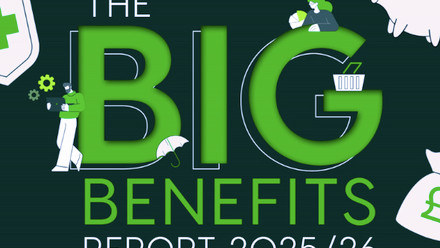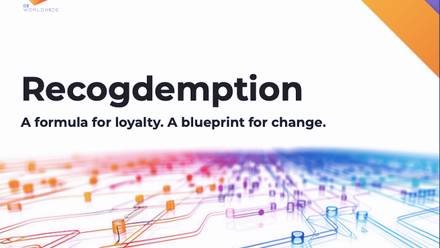How to use reward and recognition programmes to drive employee engagement

That’s why reward and recognition programmes are so valuable. According to Globoforce’s The ROI of Recognition in Building a More Human Workplace (2016) survey, 79% of employees claimed that recognition makes them work harder, and 78% were more productive after being rewarded. On top of that, it was found that businesses with strategic recognition in place are almost 50% more likely to experience high employee engagement.
But it’s simply not enough to implement a reward and recognition programme. To truly drive employee engagement you need to ensure your programme is inclusive, aligned to your business’ values, delivers meaningful rewards and enables recognition to be shared in a timely way, as well as across your business. That way, your reward and recognition programme will be optimised to effectively drive motivation, productivity and engagement throughout the pandemic and beyond.
1. Integrate your company values
To be engaged at work, it’s critical that employees understand the ‘why’ behind what they’re doing and your business’ strategic narrative. In fact, a study by Gallup found that 77% of employees who understood what their company stands for strongly agreed that they’d stay with the company for at least one year. It’s therefore important for your reward and recognition programme to be built around your company values. After all, your values encapsulate what your business stands for, contribute to your strategic narrative and set out the way in which you expect employees to conduct themselves.
Highlighting specific examples of employees living your values is therefore a great way to connect your people to a purpose and reinforce what they should be aiming for in their day-to-day roles. Very quickly, having seen how certain actions and achievements illustrate your values from other instances of recognition across the business, your employees will get a clear understanding of what positive behaviours they should emulate. Whether it’s ‘excellence’, ‘teamwork’ or ‘innovation’, your values will inspire your employees to go the extra mile and be part of your business’ journey.
2. Make sure it’s inclusive
Feeling truly valued and an accepted part of the workplace community are key elements that influence employee engagement, which is why inclusivity is so important when it comes to your reward and recognition programme. Everyone in your business should have the same opportunity to receive recognition and rewards, regardless of their position, team or location.
That’s why peer-to-peer recognition tools are so valuable. They give every employee the ability to nominate a colleague to share their appreciation and shine a spotlight on individuals doing great things across the business. Being able to freely show gratitude to colleagues and receive it back promotes collaboration, drives a sense of team spirit and motivates employees to demonstrate positive behaviour in their day-to-day lives at work, all of which is conducive to engagement.
Peer-to-peer recognition also supports one of the four enablers of employee engagement – employee voice. With the tool, employees have the freedom to use their voice at any point which will not only help deepen a culture of appreciation in the business, but demonstrates to employees that their views are valued.
3. Deliver meaningful and relevant rewards
Your reward and recognition programme won’t effectively drive employee engagement if the rewards you deliver don’t have an impact on individuals. Meaning and relevance are everything. They are what will motivate your employees to repeat positive behaviours and encourage others to do the same.
There’s no ‘one size fits all’ approach to this. Employees are individuals and therefore motivated by different things. That’s why reward points are a useful mechanism to deliver rewards because instead of giving employees something that they may not necessarily value, you’re giving them the opportunity to choose their own rewards depending on the amount of points they have. They might buy a watch, an experience day or even a gift for someone else, but what they use their reward points on will almost certainly have more meaning and relevance to them. That way, their reward will have a lasting impact and be more motivating and engaging in the long run.
4. Share recognition company-wide
While private recognition can be effective, many businesses underestimate the benefits of making it visible company wide. First off, sharing a “thank you” to an employee with a wider audience puts that employee in the limelight and magnifies the impact of the recognition. Knowing that everyone in the business can see that they’ve been recognised and is therefore aware of the great work they’ve done sends a powerful message to employees that their efforts are truly valued.
With a social wall or real-time feed of recognition, other employees have the opportunity to reinforce their own gratitude and congratulate their colleague too. This adds even more weight to the initial recognition. On top of that, seeing all instances of recognition in a real-time feed demonstrates to other employees what kind of behaviour and actions are worthy of praise. As we mentioned when discussing company values, you’ll provide a source of motivation for other people, not just the employee that’s been recognised.
5. Recognise employees and deliver rewards in a timely manner
The length of time it takes your business to recognise or reward employees can make a real difference to the impact it has on the individual. One particular research report found that an immediate bonus led to an almost 20% increase in the amount of people sticking with the task at hand. Imagine doing a great job and receiving recognition a few months later. It doesn’t quite have the same effect, does it? That’s why on-the-spot recognition and delivering rewards in the moment are powerful.
Thanks to technology, it’s very easy to do that. You can build processes into your reward and recognition platform so managers can quickly and easily allocate reward points or send a physical gift to an individual or team on the spot. It can be as simple as clicking a few buttons. By doing this, achievements can be celebrated in the moment meaning that employees will be more likely to remain motivated, productive and engaged.
Reward and recognition programmes are essential tools that drive employee engagement but it’s important to integrate your company values, ensure it’s inclusive, deliver meaningful rewards, share recognition company-wide and deliver timely recognition and rewards. By doing this, you’ll have a better chance of driving long-term change in your workforce and reaching a place of optimal employee engagement.
This article is provided by peoplevalue.
Supplied by REBA Associate Member, peoplevalue – The Employee Engagement Company
We are a leading provider of employee reward&recognition, benefits delivery&wellbeing solutions.







